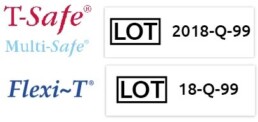Lot numbers copper coils: how does it work and where to find them?
Titus Health Care offers a replacement free of charge T-Safe, Multi-Safe or Flexi-T copper IUD after a failed placement or expulsion within 6 months of placement. Healthcare providers easily and quickly request a replacement IUD via the online form. In this form, we ask for the spiral's lot number, among other things. But what is a lot number? Where can you find the lot number of our copper spirals and why do we ask for it on the replacement form? And why is it so important to document lot numbers? Read all about it in this blog.
What is a lottery ticket number?
Lot numbers are unique numbers assigned to a product. Each spiral has a lot number. The lot number provides information about the type of spiral and when the spiral was produced. It is important to record the lot number of each spiral placed. Tip for midwives: the Contraception portal automatically registers lottery numbers. You can then always find lottery numbers in the overview of your recipes.
Where can I find the lottery number?
Lot numbers are on the packaging of each spiral. On some packs it is printed, on others there is a sticker. It is always the information behind the letters 'LOT'. Sometimes these are just numbers, in other cases they are letters and numbers. In the picture opposite, you can see how to recognise the lot numbers of T-Safe, Multi-Safe and Flexi-T copper coils.
Lot numbers at replacement request
There are currently 22 different copper coils on the market in the Netherlands. T-Safe and Multi-Safe are the most commonly used of these. When requesting a replacement, we would like to know which coil it is. This also requires the batch number of the spiral placed. With every request, this way we try to get a complete picture of the situation. Based on the information we receive, we can give appropriate advice and best help healthcare providers.
Why document lot numbers of placed spirals?
It is important to document which patient received which coil from which batch. Firstly, this is important to know when a recall occurs, for example. Fortunately, it happens rarely, but if a manufacturer identifies that there is a production problem, a recall is initiated. The notice then states which lot numbers are involved. But what if you can no longer find out who has which coil? Right, then in the worst case scenario you have to have all your patients come back for spiral removal.
Second, as with any drug, a patient may suffer a side effect or there may be a product complaint. The producer reports this to the manufacturer. The manufacturer then investigates this particular coil and the batch of coils produced at the time. For example, the manufacturer can find out if there have been multiple reports in one batch and determine whether action may need to be taken.
Documenting what else?
Besides the lot number, there are more details that are useful to document at insertion. We always recommend noting the following data in the patient record:
- the type of spiral (T-Safe, Multi-Safe (short), Flexi-T)
- expiry date of the spiral
- date of insertion
- measured probe length
- any particularities during insertion
Specifics might include postpartum placement or a woman who is breastfeeding.
More information
Still in doubt or have any questions? Then get in touch via medical@titushealthcare.nl.


